

The Hidden City Cont.
Measuring
The Levitical City
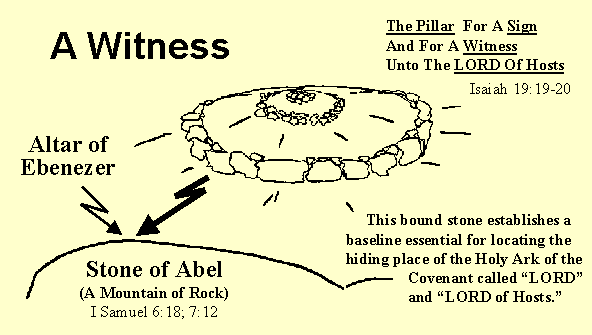
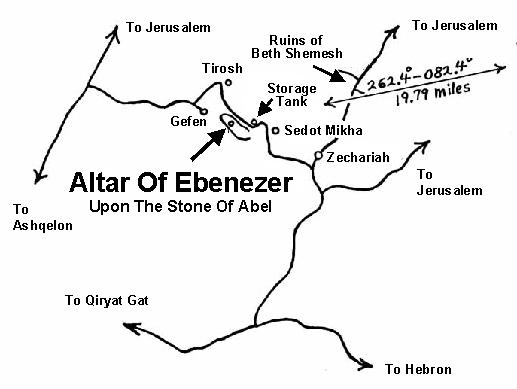
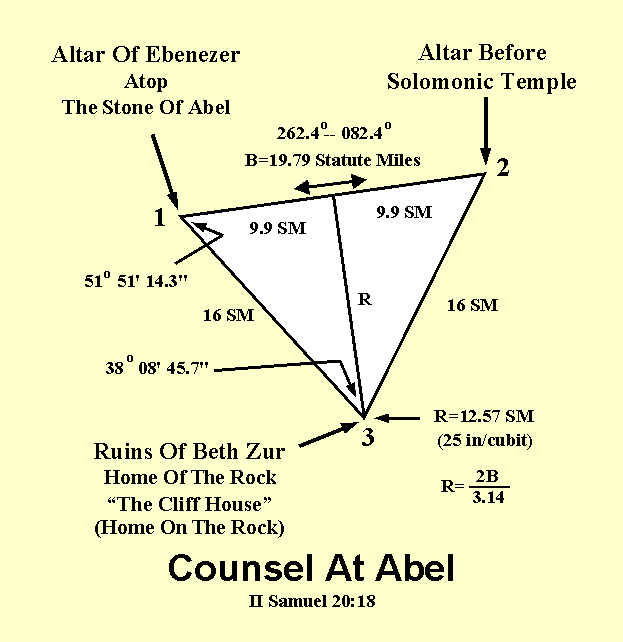
Eventually, that amphitheatre was burned and probably completely demolished.†† However, the base of the Altar is precisely positioned in the midst of the court before the Temple and should be easily found perhaps without the brazen upper portion which may have gone to Babylon.†† The Temple itself was collapsed in a specific manner by Zedekiah and those with him to preserve the inner portion and prevent the Babylonians from entering therein.†† Remember, the Solomonic Temple faced West so the face of the porch will be found a specific distance East of the Altar.
Yes, the Old Testament and the Talmud say the Levitical City is 2,000 cubits on a side; whereas, The Temple Scroll says it is 1,600 cubits on a side.†† The great amphitheatre has three gates per side and Hecataeus described the great walled enclosure as having double gates.†† Actually, there are hundreds of references that all fit together quite nicely.†† It's when "the experts" sweep this reference and that reference "under the rug" because they don't understand ... that's when they get even more confused.
Again, we have suggested starting at the Altar of Ebenezer (Isaiah 19:19-20) for a reason.†† That is, Scripture uses Ebenezer as a key reference point; "The Cliff House" upon Beth Zur should be the second visible reference point.†† Using those two points, once confirmed, one can readily affirm the location of the center point of the Altar before the Solomonic Temple.
Today GPS (Global Positioning System) can accurately pin point items, measure distances and coordinates, etc.†† However, we understand that GPS units require calibration using a known geographic survey marker as underwater salvage people, for example, claim the military routinely insert "fudge factors" that displace or offset the true coordinates.
Then once the Altar is uncovered, measures of the Altar reveal the measure of the precise cubit used.†† With that information the exact location of all features of the Temple, the Levitical City, roads, gates, etc. can be identified.†† It's that simple.
We've already used Ebenezer upon Abel to locate things with amazing accuracy.†† And we found Ebenezer by using a particular point in Independence Garden Park as described in our websites that you have visited.†† We now suggest that you triangulate using a GPS unit to locate that same particular point atop the Altar before the Solomonic Temple while taking photographs and video as you progress.†† You, of course, will be doing the reverse of what we've already done only using two points and three sides of a triangle; whereas, we actually used a point, azimuth, and distance to locate Ebenezer atop Abel.
Note:† Accuracy was not a factor when we searched out Ebenezer upon Abel.†† That is, it was precisely where we anticipated it to be; but, if we were off a few hundred feet, Ebenezer is 40 feet in diameter and rests right atop the ground on the high point of the landscape.†† Finding it was a "piece of cake!"†† We walked directly to it on the very first try.†† And if we had been off by a few hundred feet or more we could have found it anyway.
Conversely, the Altar before the Solomonic Temple is well buried and hidden from view so here accuracy is an important factor.†† Scripture provides: (1) a baseline, (2) an anchor at Ebenezer, and (3) the three "Shemeshes" indicate that a second point should be found at Beth Zur (very probably "The Cliff House" as it identifies a specific point.†† See the attached diagram titled:† "Counsel At Abel":† II Samuel 20:18).†† If measures between Ebenezer and Beth Zur agree then the probability is very great that point #2 (on diagram) is directly atop the Altar before the Solomonic Temple.
Excavating the Levitical City and the Solomonic Temple ruins from the Surface should be a major undertaking.†† However, reentry of the preserved inner Temple via the sewer outflow should be relatively easy (Details have been explained in "Reentering Temple History A and B").†† A third approach would be to reenter via the tunnel from fresh water springs to the Northwest of the Solomonic Temple site.†† However, the nearest access hole complete with steps to the watercourse is full of rocks apparently thanks to King Hezekiah.†† Smile!
The Altar Placement In The Center Of The Court Before The Temple:† The foundation of the base of the Altar is 32 cubits by 32 cubits according to Middoth (measurements) 3:1 (the Kodashem of the Talmud).†† From the edge of this base of the Altar go 12 cubits Eastward to the lowest step (the first step) to enter the Solomonic Temple.†† The depth of the steps to the Temple is 22 cubits measuring from the bottom step to the face of the Temple Porch.†† Thus, measuring from the center of the Altar 16 + 12 + 22 = 50 cubits.†† And 50 cubits is the measure to the center of the court before the Temple measuring from the face of the Temple Porch (Middoth 3:1,6; 5:1).
Now measuring from the bottom of the steps of the Temple to the far (West) edge of the Altar ramp is 62 cubits (Middoth 5:2).
Also, measuring from the (East) edge of the Altar nearest the Temple to the West side of the Altar ramp is 50 cubits.†† This measure includes both the Altar (32 cubits) and the width of the ramp (18 cubits).†† This measurement point matches the 62 cubits of Middoth 5:2 as 62 minus 12 equals 50 cubits (Josephus, War of the Jews, Book 5, Chapter 5, Section 6).†† Again, the 12 cubits is the distance from the base of the Altar to the first (bottom) step of the Temple's main entrance.
Note:† The Middoth describes the Base of the Altar in detail, whereas, II Chronicles 4:1; Ezekiel 43:12-13; etc. pick up at the 20 cubit by 20 cubit portion described as the place for the Altar fire which is 10 cubits above the pavement of the court before the Temple.
Excavating The City:† When the Altar is excavated and the cubit measures confirmed, the precise measures and placement of all elements of the Levitical City can be determined.†† Sample trenches can confirm the placement of roads, gates, walls, housing units, the exterior of the amphitheatre, and the Temple heap within the ancient amphitheatre.†† Yes, 5Q15 says, "And all (the streets of the city) are paved with white stone ... marble and jasper." (See item 6 of 5Q15 quoted from File 5 of 6 herewith).
|
A Colossal Brass Dome Overlaid With Gold Enclosed The Temple, The Inner And Outer Temple Courts, And A Huge Tri-Level Amphitheatre
The Ancient Levitical City Of Jerusalem Built By Solomon On Melchizedek's Holy Mount West Of The Hinnom (Joshua 15:8; Jeremiah 19:2 KJV). |
Scripture gives us partial measures for Noah's ark as being 300 by 50 cubits by 30 cubits high (Genesis 6:15).†† O.K., the 300 by 50 fit nicely as measures of the Temple Amphitheatre that facilitated seating for the flock, restaurants (cooking facilities in the corners), and even a Temple in one quadrant with its Holy of Holies and Throne Room therein.
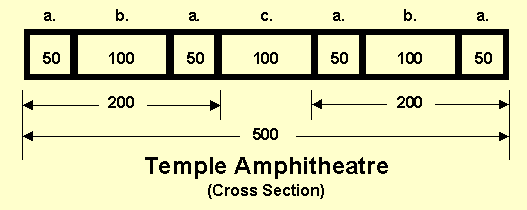
b. = Measure between gates: (100 cubits): Ezekiel 40:23.
c. = Court before the Temple (100 cubits):† court centered in amphitheatre:† Ezekiel 40:47; 41:14.
b. + c. + b. = 300 cubits total (open areas): Genesis 6:15.
length = 500 cubits = 5 stades (Berossus):† Ezekiel 42:16-20; 45:2; Middoth 2:1 (Talmud).
width = 200 cubits = 2 stades (Berossus).
The Temple, of course, occupies one quadrant within the great amphitheatre, the "stone-walled enclosure."
Note:† In these latter days, the LORD'S Day wherein we now dwell, John was told not to be concerned about the amphitheatre measures, i.e. measuring "the court without the Temple," as the End Times amphitheatre will be much larger and of modern design and materials (Revelation 11:1-2).

Suburb Extension = 1000 cubits:† Numbers 35:4.

h. = 400 cubit housing areas:† II Kings 14:13; 5Q15 (Qumran).
w. = 8 cubit walls:† (simple subtraction).
4 X h. = 1600 cubits:† (Temple Scroll:† col. 40:8).
The purpose of the triple gates facilitated RIGHT HAND TRAFFIC for vehicles, horses, carts, etc.:† Ezekiel 46:9 (East then West side); Middoth 2:2 (West side); 4:2 (East side).†† The center of the triple gates facilitated pedestrian traffic.†† Thus, there were broad avenues from each gate around the City and to the Temple Amphitheatre centered therein.
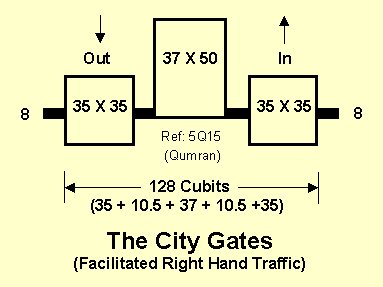
Select The Hidden City File:
Or Return To: MENU At Brian's Annex |
Prepared By Father & Son Team: George & Dana Brown P.O. Box 320932 Cocoa Beach, Florida USA 32932  |